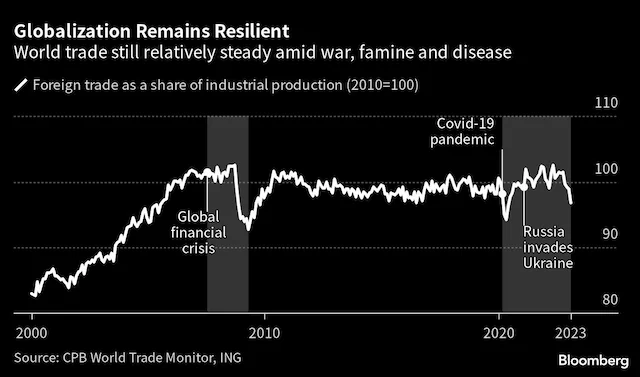
World trade data shows early signs of ‘reglobalisation’ across countries
NEW YORK : The global trading system is undergoing tectonic shifts that will reorient international supply chains for decades to come.
Blame two main forces. Companies spooked by pandemic shortages, price spikes and shipping disruptions are reducing reliances on a single factory or country. Meanwhile, governments — especially those in the US and Europe — want to ensure access to key materials like semiconductors and rare-earth minerals in case the world trade splinters into geopolitical blocs.
The transformation that some are calling “reglobalization” will take years, and trade data is only beginning to offer clues about the scope of the changes, and who’s winning and losing. Here are eight indicators to watch to help understand the implications of this new era of geostrategic economics.

Despite talk of globalization’s demise, economic integration via cross-border commerce has shown remarkable resilience through war, famine and a pandemic. Over the past three years, world trade as a share of global production has softened a bit but remains largely in line with historical trends. In fact, there has been no meaningful shift in the trajectory toward greater trade openness since at least 2006, according to a recent ING Groep NV analysis.
The increase of geopolitical tensions between Washington and Beijing spurred speculation about a sectoral decoupling between the world’s largest economies. While the value of US imports of Chinese goods and services reached the highest on record in 2022, there are signs that US tariffs are shifting bilateral trade flows. Last year, US goods imports from China that are subject to tariffs fell by about 14% versus 2017 pre-trade war levels, according to analysis from Chad Bown, a senior fellow at the Peterson Institute for International Economics.
Over the past five years, US tariffs, export restrictions and subsidies have persuaded American companies to diversify their imports away from China. The total share of Chinese imports to the US has slipped about 3 percentage points since 2018, when former President Donald Trump imposed tariffs on thousands of Chinese goods. During this time, China ceded a portion of its share of total US imports to other Asian export nations like Vietnam, India, Taiwan, Malaysia and Thailand.
Source : Bloomberg
